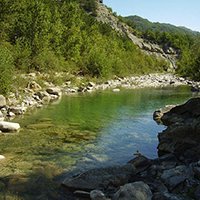Pioneer annual vegetation of gravel-bed rivers: first insights on environmental drivers from three Apennine streams

All claims expressed in this article are solely those of the authors and do not necessarily represent those of their affiliated organizations, or those of the publisher, the editors and the reviewers. Any product that may be evaluated in this article or claim that may be made by its manufacturer is not guaranteed or endorsed by the publisher.
Authors
A huge knowledge gap exists on riverine pioneer vegetation. Despite its relevance in regulating the C metabolism at the catchment scale, and the triggering role in shrubs and trees establishment along riverbanks, little data is available on its environmental determinants. Indeed, most existing knowledge in this field refers to woody species or aquatic macrophytes neglecting the ecosystem relevance of ephemeral herbaceous vegetation. Focusing on three gravel bed rivers located in northern Italy (Baganza, Nure and Parma streams), the present study is aimed to evaluate the riverine ephemeral plant richness, considering both native and alien taxa, and the role of hydrogeomorphological disturbance and sediment quality in the observed richness patterns. At higher disturbance rates (e.g., larger river sizes), our data indicate a progressive decrease in overall plant richness, but also an increase in the coverage-abundance rates mainly due to alien species. This evidence confirms that variations in hydrology imply changes in pioneer plant species richness at in-stream periodically exposed sediments. More attention must be given to the vulnerability of pioneer vegetation to climate change and direct human impacts to fully understand the functioning of lotic ecosystems, especially the non-perennial ones.
Supporting Agencies
Italian Ministry for Education, University and ResearchHow to Cite

This work is licensed under a Creative Commons Attribution-NonCommercial 4.0 International License.






